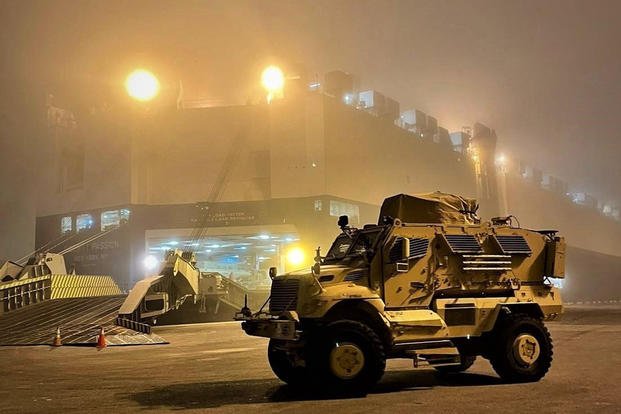Beginning this fall, Army combat units tapped for training or real-world missions no longer will deploy with their major combat systems, but instead draw their equipment from war stocks that are prepositioned around the globe.
"We've got prepositioned stocks in lots of countries, and we need to pay more attention to it, and it needs to become part of our activities that we perform upon deployment," Lt. Gen. Charles Flynn, Army deputy chief of staff, G-3/5/7, told Military.com in a phone interview. "We need to do a better job when we deploy our forces at the drawing of Army prepositioned stocks. We need to access them more, because it creates speed in our movement."
The Army has five caches -- four land-based, one afloat -- of combat vehicles and other large warfighting equipment prepositioned around the world, at the ready for a major mission or contingency.
The change to rely more on these stocks is part of the Army's Regionally Aligned Readiness and Modernization Model, or ReARMM. That effort is intended to align combat forces with combatant commands in priority regions such as the Indo-Pacific and Europe.
Read Next: Wearable Health Monitors Could Lead to Mentally Tougher Troops, Experts Say
"We want our units to be able to get ready for the place where they're likely to operate in, and then we're also trying to give units an idea of the environment that they're likely to operate in -- everything from the weather to the road networks, to the bridging network, to the enemy, to the friendly, to the commanders, to the war plans," Flynn said.
Beginning Oct. 1, the Army's I Corps, which commands the 25th Infantry Division; three Stryker Brigade Combat Teams; and combat aviation, artillery and other combat assets will be assigned permanently to the Indo-Pacific region. Army V Corps will be dedicated to the European theater, overseeing the two combat brigades based on the continent and the permanent rotation of an armored combat brigade.
The Army's rapidly deployable XVIII Airborne Corps units, such as the 82nd Airborne and 10st Airborne, and heavy forces in III Corps, such as the 1st Cavalry Division and 1st Armored Division, will continue to remain available for worldwide deployment, Flynn said.
"So, what you really have is ... I Corps focused on the Indo-Pacific, you have V Corps today focused on Europe, the two priority theaters," Flynn said. "And then we have a heavy corps that's globally available, and we have a light, joint forcible-entry corps that's globally available now."
Units in the active force will be on 24-month rotations under ReARRM. Active-duty units will cycle through eight months each of modernization, training and missions.
During rehearsals for ReARRM, Flynn said the Army considered six-, eight- and 12-month rotational windows.
"We landed on an eight-month window, because 12 was too long, and six was too short," Flynn said.
National Guard and Reserve units will be part of ReARRM, but they will have extended phases because their timelines are different from the active force, Flynn said.
The new eight-month modernization window, which replaces the old support window, is designed to allow units time to be equipped with new combat systems being developed under the Army's sweeping modernization strategy -- an effort to begin replacing Cold War combat systems such as the UH-60 Black Hawk helicopter, Bradley fighting vehicle and the Patriot air defense system over the next decade.
Units will use this eight-month period to turn in old equipment and conduct training on newly fielded systems that could range from the Next Generation Squad Weapon, hitting the force in 2022, to the Future Long Range Assault Aircraft, part of the the Future Vertical Lift effort, coming online in the 2030 timeframe.
Units also would send soldiers to professional development and leadership courses and go on block leave during the modernization window, Flynn said.
"We really need this window to account for modernization tasks, unit reorganizations," Flynn said. "We needed, you know, sort of a flexible time in the unit life cycle to have landing spots for new equipment, or to get rid of older equipment."
As part of the effort, the Army is placing greater emphasis matching the equipment in prepositioned war stocks to the needs of units in Europe, Indo-Pacific and other regions, Flynn said.
While prepositioned stocks in the Middle East have seen use over the past two decades amid wars in Iraq and Afghanistan and operations in Syria, the Army has not regularly employed its prepositioned resources in Europe and the Pacific.
"We're going to better match our prepositioned stocks forward to the units that are aligned with that mission set," said Flynn, who was reluctant to provide specific details. "It is changing quite a bit because we've not always had that matching.
"The goal would be to use it more often and exercise it more often because it's a combat deployment task. ... We have it forward; we might as well use it."
-- Matthew Cox can be reached at matthew.cox@military.com.
Related: The Army Is Reorganizing Its SFAB Units to Deploy Globally












